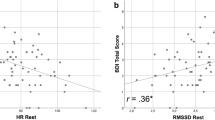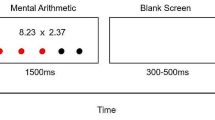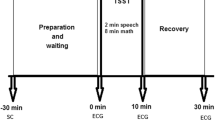Abstract
Cardiovascular disease is the leading killer of women in developed countries. Menopause, stress, and lack of social support may contribute to the increased risk of heart disease morbidity and mortality in women. This study examined the effects of psychological stress and social support on autonomic nervous system control of the heart in 18 pre- and 34 postmenopausal women. Autonomic activity, as indexed by high-frequency heart rate variability and pre-ejection period, was assessed at rest and during a public speech task. Social support was determined using the Berkman Social Support Inventory. Postmenopausal women had higher heart rate (F = 4.4, p ≤ .04) and less para-sympathetic activity (F = 11.9, p ≤ .001) compared with premenopausal women at rest. In response to stress, sympathetic nervous system activity increased in postmemopausal women (F = 6.1,p≤. 02); however, this effect was no longer significant when age was used as a covariate in the analysis. Social support did not significantly affect measures of autonomic activity in either the pre- or postmenopausal women. Postmenopausal women have greater sympathetic and less parasympa-thetic activity than premenopausal women, which may account for their increased risk of coronary artery disease.
Similar content being viewed by others
References
Hoyert DL, Kochanek KD, Murphy SL: Deaths: Final data for 1997. InNational Vital Statistics Reports, DHHS Publication No. 99-1120. Hyattsville, MD: National Center for Health Statistics, 1999.
Eaker ED, Chesebro JH, Sacks FM, et al.: Cardiovascular disease in women.Circulation. 1993,88:1999–2009.
Kaplan JR, Pettersson K, Manuck SB, Olsson G: Role of sympathoadrenal medullary activation in the initiation and progression of atherosclerosis.Circulation. 1991,84 (Suppl. VI):V123-V132.
Rosano GMC, Patrizi R, Leonardo F, et al.: The effect of estrogen replacement therapy on heart rate variability and heart rate in healthy postmenopausal women.American Journal of Cardiology. 1997,80:815–817.
Tennant C: Life stress, social support and coronary heart disease.Australian and New Zealand Journal of Psychiatry. 1999,33:636–641.
Sloan RP, Shapiro PA, Bagiella E, Myers MM, Gorman JM: Cardiac autonomic control buffers blood pressure variability responses to challenge: A psychophysiological model of coronary artery disease.Psychosomatic Medicine. 1999,61:58–68.
Fukudo S, Lane JD, Anderson NB, et al.: Accentuated vagal antagonism of beta-adrenergic effects on ventricular repolarization.Circulation. 1992,85:2045–2053.
Manuck SB, Kaplan JR, Matthews KA: Behavioral antecedents of coronary heart disease and atherosclerosis.Atherosclerosis. 1986,6:2–14.
Barrett-Connor E: Estrogen and estrogen-progesten replacement: Therapy and cardiovascular disease.American Journal of Medicine. 1993,5A:40S-43S.
Berntson GG, Cacioppo JT, Quigley KS: Autonomic determinism: The modes of autonomic control, the doctrine of autonomic space, and the laws of autonomic constraint.Psychological Review. 1991,98:459–487.
Uchino BN, Cacioppo JT: The relationship between social support and physiological processes: A review with emphasis on underlying mechanisms and implications for health.Psychological Bulletin. 1996,119:488–531.
Bigger JT Jr, Fleiss JL, Steinman RC, et al.: RR variability in healthy, middle-aged persons compared with patients with chronic coronary heart disease or recent acute myocardial infarction.Circulation. 1995,91:1936–1943.
Pagani M, Lombardi G, Guzzetti S, et al.: Power spectral analysis of heart rate and arterial pressure variabilities as a marker of sympathy-vagal interaction in man and conscious dog.Circulation Research. 1986,59:178–193.
Baselli G, Cerutti S, Civardi S, Malliani A, Pagani M: Cardiovascular variability signals: Towards the identification of a closed-loop model of the neural control mechanisms.IEEE Transactions on Biomedical Engineering. 1988,35:1033–1046.
Randall WC: Sympathetic control of the heart. In Randall WC (ed),Neural Regulation of the Heart. New York: Oxford University Press, 1977, 56–70.
Cohen S, Kaplan JR, Manuck SB: Social support and coronary heart disease: Underlying psychological and biological mechanisms. In Shumaker SA, Czajkowski SM (eds),Social Support andCardiovascularDisease. NewYork:Plenum, 1994, 195–222.
Mills PJ, Ziegler MG, Nelesen RA, Kennedy BP: The effects of the menstrual cycle, race, and gender on adrenergic receptors and agonists.Clinical Pharmacology & Therapeutics. 1996,60:99–104.
Nelesen RA, Shaw R, Ziegler M, Dimsdale J: Impedance cardi-ography derived hemodynamic responses during baroreceptor testing with amyl nitrite and phenylephrine.Psychophysiology. 1999,36:105–108.
Berkman LF, Syme, SL: Social networks, host resistance, and mortality: A nine-year follow-up study of Alameda County residents.American Journal of Epidemiology. 1979,109:186–204.
Kang SH, Bloom JR: Social support and cancer screening among older Black Americans.Journal of the National Cancer Institute. 1993,85:737–742.
Seals D, Esler M: Human aging and the sympathoadrenal system.The Journal of Physiology. 2000,528:407–417.
Van Ravenswaaij-Arts CMA, Kollee LAA, Hopman JCW, et al.: Heart rate variability.Annals of Internal Medicine. 1993,118:436–447.
Seeman TE, Robbins RJ: Aging and the hypothalamic-pitu-itary-adrenal response to challenge in humans.Endocrine Reviews. 1996,15:133–260.
De Meersman RE: Heart rate variability and aerobic fitness.American Heart Journal. 1993,125:726–731.
Tulppo MP, Mäkikallio TH, Seppänen T, et al.: Vagal modulation of heart rate during exercise: Effects of age and physical fitness.American Journal of Physiology. 1998,274(2, Pt. 2):H424-H429.
Author information
Authors and Affiliations
Corresponding author
Additional information
This work was supported by Grants AG-13332, MO1-RR00827, and HL-57265 from the National Institutes of Health.
We thank the research participants. We also gratefully acknowledge the efforts of Dr. Jose Loredo, M.D. in conducting the physical examinations for our participants and Elaine Dillon, R.N. for her hard work on this research study.
About this article
Cite this article
Farag, N.H., Bardwell, W.A., Nelesen, R.A. et al. Autonomic responses to psychological stress: The influence of menopausal status. ann. behav. med. 26, 134–138 (2003). https://doi.org/10.1207/S15324796ABM2602_05
Issue Date:
DOI: https://doi.org/10.1207/S15324796ABM2602_05




